|
|
|
|
Iroquois Confederacy
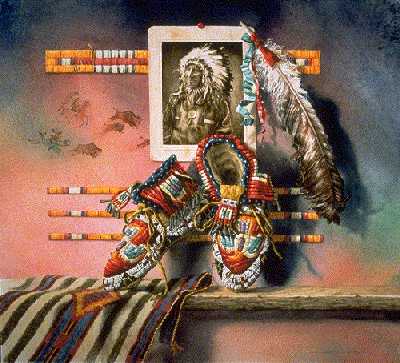 Traditional Culture and Political Organization Traditional Culture and Political Organization
Dance
Their material culture was the most advanced of the Eastern Woodlands area, but they exhibited many traits peculiar to other areas, and this leads many authorities to believe that the Iroquois at some time in the distant past migrated from the lower Mississippi valley. They lived in palisaded villages; the men hunted deer and small game, and the women raised corn, squash, tobacco, and beans. Women held a high status in the society, and descent was matrilineal. Even before the formation of the confederation, the Iroquois families lived in the distinctive bark-covered rectangular structure known as the long house.
When the prophet Deganawidah and his disciple Hiawatha founded (c.1570) the confederacy (to eliminate incessant intertribal warfare and to end cannibalism), this dwelling became the symbol of the Five Nations. They thought of themselves metaphorically as dwelling in a large long house, which had a door on the eastern end, guarded by the Mohawk (in the extreme geographical east), and a door on the western end, guarded by the Seneca (in the extreme west). The Onondaga, keepers of the council fires and the wampum records, were between the Cayuga on the west and the Oneida on the east. The main Onondaga village served as the capital, or meeting place, of the federated council. Voting in the council was conducted by tribe, and a unanimous decision was necessary to wage war. Nevertheless, intertribal war was not unknown. Hiawatha
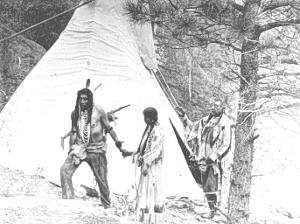 fl. c.1550, Legendary chief of the Onondaga of North America. He is credited with founding the Iroquois Confederacy. He is the hero of the well-known poem by Henry Wadsworth Longfellow. See T. R. Henry, Wilderness Messiah (1955). Rise to Power fl. c.1550, Legendary chief of the Onondaga of North America. He is credited with founding the Iroquois Confederacy. He is the hero of the well-known poem by Henry Wadsworth Longfellow. See T. R. Henry, Wilderness Messiah (1955). Rise to Power
The Iroquois were second to no other Native Americans N of Mexico in political organization, statecraft, and military prowess. In the mid-17th century the Iroquois Confederacy, equipped with Dutch firearms, made its united force felt. It dispersed the Huron in 1649, the Tobacco and the Neutral Nation in 1650, the Erie in 1656, the Conestoga in 1675, and the Illinois c.1700. Depleted by continual warfare, they increased the population by the wholesale adoption of alien tribes, so that by the end of the 17th century they numbered some 16,000. At this time they controlled the territory bounded by the Kennebec River, the Ottawa River, the Illinois River, and the Tennessee River. Their conquests were checked in the west by the Ojibwa, in the south by the Cherokee and the Catawba, and in the north by the French. Relationship with the French and the British
Many historians argue that the hostility of the Iroquois toward the French was caused by Samuel Champlain when in 1609 he accompanied a Huron war party armed with French guns into Iroquois territory. In any case, the Iroquois, firm allies of the British, opposed the French at every step until the French lost control of Canada in 1763. The French, partly in the hope of winning over the Iroquois, sent missionaries to them. Isaac Jogues, a notable Jesuit missionary, was killed by the Iroquois as a sorcerer in 1646, but the missionaries were somewhat successful, and a considerable number of the Mohawk withdrew from the confederacy and founded (c. 1670) a Catholic settlement. These Catholic Iroquois, called French Mohawks, took the part of the French against their former brethren.
In the early 18th century the Five Nations became the Six Nations when the Oneida adopted (c.1722) the remnants of the Tuscarora Confederacy. British settlers had expelled (1711) the Tuscarora from North Carolina, and by 1712 they had moved north. The British, who had used the Six Nations as a buffer against the advance of the French from Canada in the French and Indian Wars, attempted to retain their favor by accrediting various agents, notably Sir William Johnson (Johnson of the Mohawks). In the American Revolution
The American Revolution was disastrous for the Iroquois. The confederacy, as such, refused to take part in the conflict but allowed each tribe to decide for itself, and all the tribes, except the Oneida, joined the British. Samuel Kirkland, a Protestant missionary, was largely responsible for winning over the Oneida, who rallied to the side of the colonists after remaining neutral for two years.

Cornplanter, Red Jacket, and Joseph Brant (who was educated by Sir William Johnson) led the Iroquois who remained loyal to the British. Brant, the principal leader of the Iroquois troops, participated with the Tory Rangers of Walter Butler in raids in New York and Pennsylvania, particularly the Cherry Valley and Wyoming Valley massacres. The Continental Congress sent out a punitive expedition under John Sullivan, who in 1779 defeated Butler and his Iroquois allies. After the Revolution, Brant, in contrast to the other two chiefs, remained adamant in his hostility towards the United States. Cornplanter
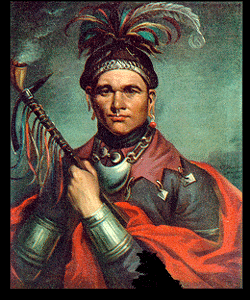
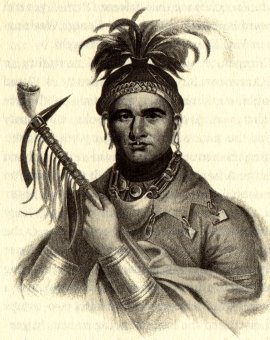 c.1740-1836, chief of the Seneca. The son of a Native American mother and a white father, he acquired great influence among the Seneca and in the American Revolution led war parties for the British against the colonial forces, particularly against Gen. John Sullivan in New York. He later favored friendship with the whites and signed the Treaty of Fort Stanwix (1784). He was given a grant of land on the Allegheny River, where he lived to a very old age. His views were opposed by the energetic Red Jacket but supported by Handsome Lake (Cornplanter's half brother). Red Jacket c.1740-1836, chief of the Seneca. The son of a Native American mother and a white father, he acquired great influence among the Seneca and in the American Revolution led war parties for the British against the colonial forces, particularly against Gen. John Sullivan in New York. He later favored friendship with the whites and signed the Treaty of Fort Stanwix (1784). He was given a grant of land on the Allegheny River, where he lived to a very old age. His views were opposed by the energetic Red Jacket but supported by Handsome Lake (Cornplanter's half brother). Red Jacket
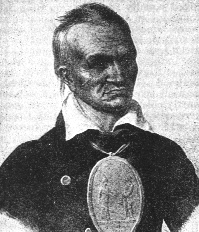
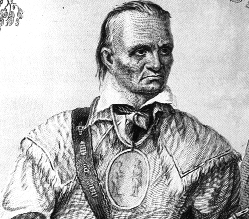
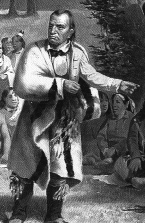 c.1758-1830, chief of the Seneca, b. probably Seneca co., N.Y. His Native American name was Otetiani, changed to Sagoyewatha when he became a chief. His English name came from the British redcoat he wore as an ally of the English in the American Revolution. He had an excellent memory and was articulate and skillful in dealing with the whites, but he was accused of cowardice by other Native American leaders in active warfare. At a Native American conference (1786) at the mouth of the Detroit River, Red Jacket urged the continuance of hostilities against the whites, but in later years he attempted to make peace with the U.S. government. He was one of the Native American chiefs who visited President George Washington in 1792. In the War of 1812 he influenced his people to support the United States. An ardent advocate of the Native American mode of life, he resisted the introduction of white customs, especially Christianity and the work of the missionaries. Late in his life the growth of Christianity among Native Americans and opposition to his policies resulted in his being deposed as chief, but he appealed to the government, defended himself before a tribal council, and was restored. The Iroquois Today c.1758-1830, chief of the Seneca, b. probably Seneca co., N.Y. His Native American name was Otetiani, changed to Sagoyewatha when he became a chief. His English name came from the British redcoat he wore as an ally of the English in the American Revolution. He had an excellent memory and was articulate and skillful in dealing with the whites, but he was accused of cowardice by other Native American leaders in active warfare. At a Native American conference (1786) at the mouth of the Detroit River, Red Jacket urged the continuance of hostilities against the whites, but in later years he attempted to make peace with the U.S. government. He was one of the Native American chiefs who visited President George Washington in 1792. In the War of 1812 he influenced his people to support the United States. An ardent advocate of the Native American mode of life, he resisted the introduction of white customs, especially Christianity and the work of the missionaries. Late in his life the growth of Christianity among Native Americans and opposition to his policies resulted in his being deposed as chief, but he appealed to the government, defended himself before a tribal council, and was restored. The Iroquois Today
The Mohawk and the Cayuga, who were strong allies of the British, today live on reservations in Ontario, and most of the remaining Iroquois, except for the Oneida who live in Wisconsin, are in New York. The Iroquois in Canada and in the United States are either Christians or followers of Handsome Lake, a Seneca prophet of the 18th century who was influenced by the Quakers. The total number of Iroquois in the United States and Canada is around 29,000. Bibliography
The Iroquois have been the subject of much study and literature. Early students included Cadwallader Colden and Lewis Henry Morgan. See G. T. Hunt, The Wars of the Iroquois (1940, repr. 1960); F. G. Speck, The Iroquois (2d ed. 1955); J. V. Wright, The Ontario Iroquois Tradition (1966); Conference on Iroquois Research, Iroquois Culture, History and Prehistory (1967); A. F. C. Wallace, The Death and Rebirth of the Seneca (1969); Barbara Graymont, The Iroquois in the American Revolution (1972).
Get Real! Oneida Language
Don't miss this nice little site featuring some grade four students who tell
you why they are learning their native language. They've included some audio
samples for you as well.
http://www.wpt.org/getreal!/300/ONEIDA/oneida.htm
Iroquois Earth Songs
Listen to samples of authentic Iroquois music! Choose from 22 selections,
all with a brief history of the song and dance. You need the Real Player
plug-in to hear the samples.
http://www.ohwejagehka.com/songs.htm
Iroquois Information Links
See treaties and agreements, some very old photographs, a discussion about
corn, and a very interesting link to Haudenosaunee views in the late 19th
century -- a very nice site for students of Native American history. Click
the left-pointing arrow at the bottom of the page to move back to other
interesting pages.
http://tuscaroras.com/pages/irlinks_ex.html
Mohawk Nation Documents
There are a variety of statements here, some dealing with issues of the day
and others of historical nature, such as treaties. There is a link to a map
of Mohawk land.
http://kafka.uvic.ca/~vipirg/SISIS/Mohawk/main.html
Native Americans of the NorthEast
Read the brief overviews of the six tribes who comprise the Iroquois
Confederacy. As well as links to other related sites, you can go to the page
which offers the "Indian Pledge of Allegiance."
http://www.geocities.com/Athens/Oracle/5467/
Native Position on the Breakup of Canada
Not that they want it to happen, or that a breakup will occur, but the
Mohawk Nation has published a statement concerning such an eventuality.
http://kafka.uvic.ca/~vipirg/SISIS/Quebec/mohawk1.html
Oneida Indian Nation
Learn some little-known facts about the Oneida nation from this large site
which includes history, culture, art exhibits, treaties, modern education
issues, and even a cookbook. You can listen to audio files in the "Language"
section.
http://one-web.org/oneida/
The Oneida Indians
Here's another site authored by fourth graders. They provide good basic
information about the wars with the French and the Revolutionary War.
http://www.ga.k12.pa.us/academics/ls/4/sstudies/Colonial/4R/4R09.htm
Say HELLO in Mohawk
This site goes far beyond its title in scope -- you might even find your
name translated! Learn months of the year or "Mary Had a Little Lamb" in
Mohawk and read the Creation Story. You'll find much to see and do here.
http://ipl.sils.umich.edu/youth/hello/mohawk.html
Seneca
This is a fourth grader's account of two notable Seneca chiefs and the
longhouses of the Iroquois. Who are the three sisters? Find out here.
http://www.ga.k12.pa.us/academics/ls/4/sstudies/Colonial/4V/4V05.htm
Seneca Indians
This brief essay about the Seneca Indians, written by a fifth grader, offers
some good information.
http://silvercrest.silverfalls.k12.or.us/SCDOCS/5GRADE/NA/Lesli.htm
Seneca Nation Of Indians
Read the text of the Canandaigua Treaty of 1794 and get information and
contact addresses for tribal government, cultural resources, reservations,
and other areas relating to this member of the Iroquois Confederacy.
http://www.sni.org
|
|
|
|
|
|
 Native American Nations
Native American Nations
